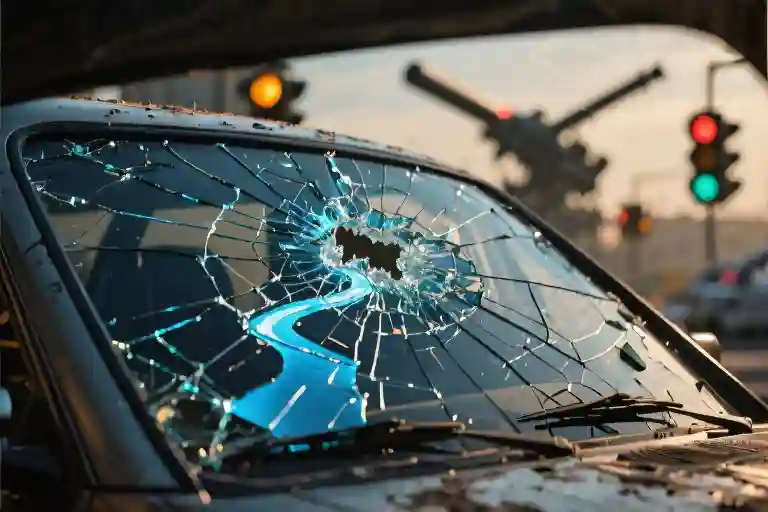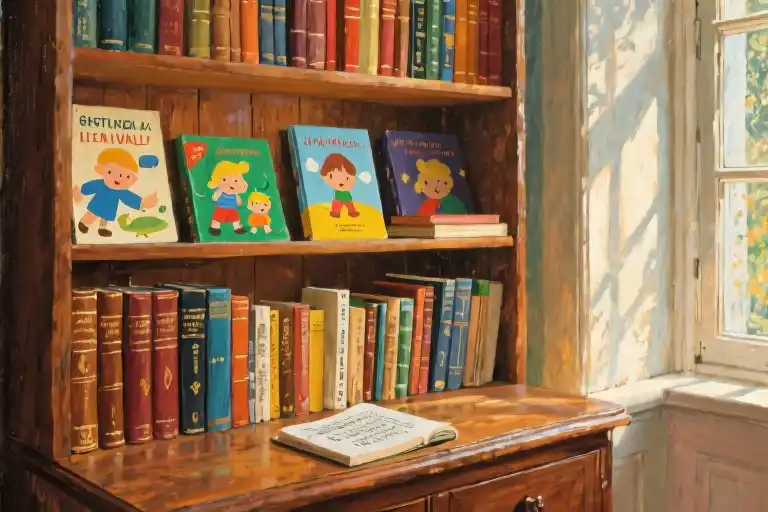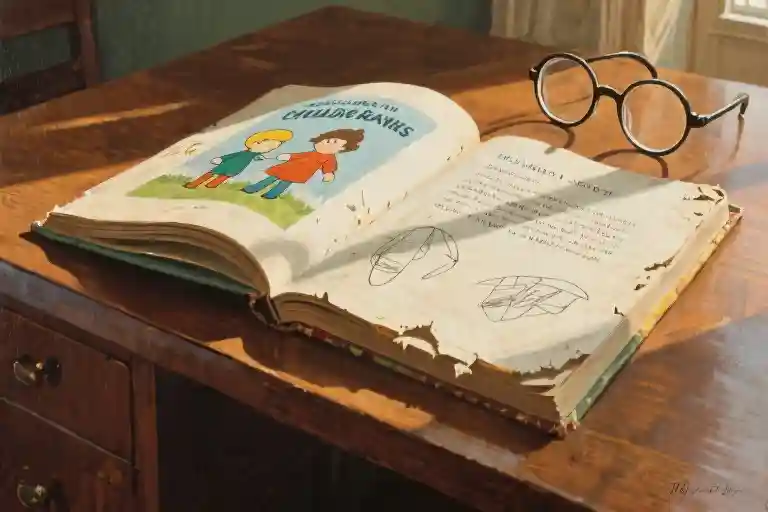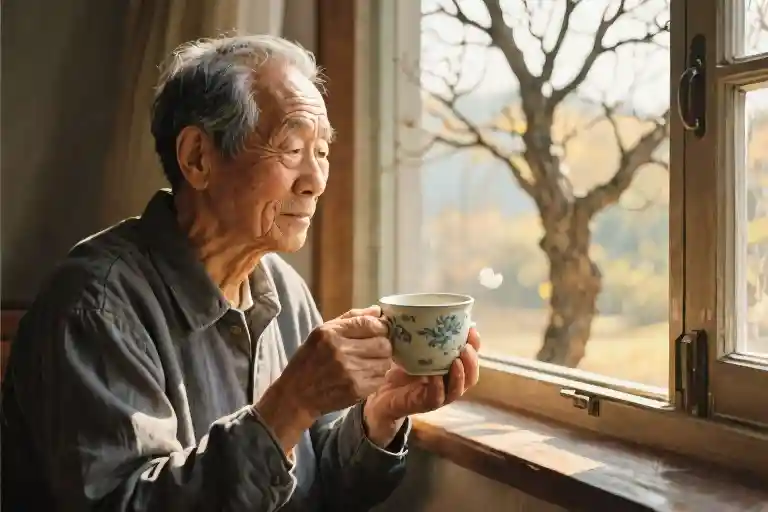The engine idled with that particular vibration that makes you check the gas gauge even when you know the tank is full. Sunlight fractured through the windshield’s spiderweb crack, casting prismatic shapes across Henry’s hands on the steering wheel—geometric ghosts dancing over his knuckles. He flexed his fingers absently, watching the light patterns shift.
Somewhere between the third and fourth pulse of the turn signal, the memory surfaced again: that boy from Baturyn who’d taught himself to paint icons on the backs of ration cards, who later molded sculptures from artillery shell casings. People said he could make art from anything—broken bricks became mosaic tiles, barbed wire transformed into delicate filigree. Then the Russians inv—
A knuckle rapped against glass. Not Henry’s passenger window, but the driver’s side window of the pickup truck beside him. The man leaning out had the kind of face that looked like it had been left too long in a back pocket—creased leather skin, a topography of scars and sun damage. What remained of his hair formed pale islands across his scalp, the pattern recalling lunar craters under morning light.
When the man made that universal rolling-down motion with his hands—fingers curled like he was holding invisible airplane controls—Henry surprised himself by complying. The window whirred obediently, though the mechanism made a sound like teeth grinding.
“You got a smoke?”
The question hung between them, ordinary and absurd. Henry watched a vein pulse in the man’s temple, noticed the yellow stain along his right index finger that might’ve been nicotine or something darker. “I’m sorry, I don’t.”
Something passed behind the man’s eyes—not disappointment exactly, but the quiet resignation of someone accustomed to withheld truths. His window ascended with a hydraulic sigh just as the traffic light cycled to green. Tires screeched as the pickup lurched forward, leaving behind the faint scent of burnt oil and what might’ve been turpentine.
Henry remained motionless, studying the crack in his windshield where it intersected with a reflection of power lines. He remembered reading somewhere that auto glass cracks follow predictable fracture patterns, always propagating toward the weakest point. Insurance used to cover that kind of damage, back when policies accounted for ordinary miracles and unavoidable tragedies. Now the fine print excluded acts of war, acts of God, and whatever this was—this suspended moment where a stranger’s moon-crater skull could make you question every kindness you’d ever offered or withheld.
The Lunar Landscape in the Passenger Seat
The man’s scalp caught the afternoon light in a way that made Henry think of crater maps. Those uneven patches of gray and white weren’t just hair loss – they formed a topography of scars that dipped and rose like artillery impacts on lunar reconnaissance photos. One particular mark near his temple spiraled outward, a frozen whirlpool of flesh that might have been a burn or perhaps something more deliberate.
His knuckles tapped the window again, that same impatient gesture flight attendants use when demonstrating oxygen masks. Three quick raps that somehow carried authority despite coming from a stranger in a rusting sedan. Henry noticed the blue-black smudge across his index finger first – too vivid for engine grease, too dark for most paints. It clung to the cuticle like a fresh tattoo, or maybe dried blood that hadn’t been scrubbed thoroughly.
The electric hum of the power window lowering seemed absurdly loud. That mechanical whir always reminded Henry of hospital beds adjusting, or the sound his father’s wheelchair made before it got stuck permanently in the reclined position. There was a metaphor there about barriers and vulnerability, but the man’s voice sandpapered through the thought.
‘You got a smoke?’
That finger with its suspicious stain now drummed on the roof of Henry’s car. Up close, the lunar scalp revealed finer details – a crosshatch of healed cuts near the crown, a pinkish depression that could’ve been a old bullet graze. The kind of head that had spent years ducking things, whether shrapnel or fists or bad memories.
When Henry shook his head, the man’s nostrils flared just enough to suggest this wasn’t his first rejection today. The window ascended with that same institutional whine, sealing away the smell of his leather jacket – not the expensive kind, but the stiff, government-issue variety that never really breaks in. Through the glass, his mouth moved again though no sound came through. Could’ve been ‘thanks’ or ‘liar’ or one of those Slavic curses Henry’s grandmother used to mutter while kneading dough.
The light was still red. Henry watched the stranger’s taillights flicker as his foot tapped the brake impatiently. That’s when he noticed the bumper sticker half-scratched off: something about artillery division reunion, the dates nearly illegible but the crossed cannons logo unmistakable. The car lurched forward on green, leaving behind a puff of exhaust that smelled suspiciously like the turpentine Henry’s art teacher used to thin oil paints.
His own windshield crack seemed to pulse in the sudden silence, branching eastward like the Dnipro River on those old maps from grandfather’s study. Funny how damage always finds its own geography.
The Boy Who Made Art from War
The Baturyn boy worked with what the war left behind. Tank treads became sculpture armatures when heated over makeshift fires, their molten metal flowing like paint from his brush. He’d wake to find artillery shell casings by his doorstep—not as weapons, but as raw material waiting to be transformed. The townspeople called it miraculous how supplies appeared, though they knew better than to question where the aluminum for his miniature monuments really came from.
Three times that afternoon at the traffic light, Henry’s mind circled back to the unfinished story:
First flash: Then the Russians invaded—
(His fingers tightened on the steering wheel)
Second flash: Then the Russians invaded the cultural—
(The bald man’s moon-crater scalp pulsed in his peripheral vision)
Third flash: Then the Russians invaded the cultural center where—
(A distant backfire made him flinch)
In the cathedral ruins, the boy had conducted strange alchemy. He’d balance stained glass shards atop jagged shell fragments, studying how sunlight passed through both. The glass cast jewel-toned shadows; the metal threw knife-edged silhouettes. When arranged just so, they composed a fractured Madonna whose tears were actually cracks in the casings.
What haunted Henry wasn’t the destruction, but the boy’s quiet certainty that materials would present themselves. A mindset from another era, before insurance adjusters measured damage in claim numbers rather than repair possibilities. These days, even a windshield crack required three forms of documentation before the glass could begin healing.
The light turned green. Through the spiderwebbed glass, the road ahead seemed to branch into countless diverging paths—not unlike the boy’s sculptures where tank parts sprouted delicate wire vines. Somewhere beyond the intersection, Henry imagined a version of himself who still believed in making beauty from broken things.
The Ballistics of a Claims Calculator
The insurance app’s augmented reality overlay trembled as it tried to make sense of the windshield crack. Henry watched his phone screen superimpose red diagnostic lines across the glass, watching as the algorithm stuttered between options: Structural Damage → Hail Impact → Vandalism? Then, for three inexplicable seconds: Art Object Detected.
He remembered the Baturyn boy who turned artillery shells into baptismal fonts. How the insurance database would classify those transformations—as damage repairs or acts of creation? The app now displayed a dropdown menu of war exclusions, clauses stacked like sandbags along the digital terms of service. 1942: Acts of God coverage extended to incendiary bombs. 2023: Excludes ‘kinetic geopolitical events.’
Outside, the traffic light cycled through its colors unnoticed. Henry traced the crack with his fingernail, feeling how its branching paths mirrored the Dnipro River’s delta on old maps. The deepest fissure aligned precisely with where the boy had painted his first mural—a grocery store wall depicting pomegranates so vivid, customers would touch the plaster expecting sticky fruit juice.
Three notification bubbles popped up:
- Claim Denied: Pre-existing condition (see 2014 policy revision 17b)
- Recommended Repair Shop: 2.3 miles → $1,200 deductible
- Did You Know? Comprehensive coverage now excludes ‘aesthetic deterioration’
The windshield wipers smeared a dead mayfly across the glass, its wings creating momentary stained-glass patterns. Henry opened the app’s dispute form, typing then erasing: The damage isn’t where the glass broke, but where it still holds together. He submitted a photo where the cracks accidentally framed the retreating taillights of the moon-headed man’s car, the red glow bleeding into the navigation app’s estimate: 19.4 minutes to Baturyn via war-affected routes.
In the claims history tab, a 1988 entry caught his eye—Sculptor’s studio fire payout denied: ‘Acts of cultural preservation not equivalent to property loss.’ The timestamp coincided with the year the Baturyn boy supposedly melted down his bronze medal to cast door handles for the bombed-out library.
Rain began dotting the windshield, each drop landing with the precision of a notary’s stamp. The largest fracture now unmistakably traced the latitude line of his childhood home. Henry pressed his palm against the glass, feeling the vibration of a truck passing, and understood with sudden clarity why the artist had always worked directly on broken surfaces—there were no claims adjusters for things already fractured, only the quiet freedom of rebuilding without permission.
The traffic light’s countdown beep bled into the air raid siren from Henry’s memory, two electronic pulses separated by decades yet harmonizing in their urgency. Blue exhaust fumes coughed from the bald man’s tailpipe as he accelerated away – the exact cobalt shade the Baturyn artist had once ground from Soviet artillery shells. Henry’s index finger hovered above the ignition, its tremor causing the windshield crack to shimmer like a river under moonlight.
What had been a random fracture now completed itself into precise cartography. The central jagged line became the Dnipro River’s northern tributary, smaller cracks branching into the streets where the self-taught sculptor once bartered mosaic tiles for bread. A starburst near the rearview mirror marked the square where the boy’s first public mural had been shelled three days after completion.
The light turned green again. Somewhere behind him, a horn blared. Henry pressed his palm against the glass, feeling the map’s ridges bite into his skin. The coordinates aligned perfectly with the artist’s last known location before the invasion. That final exhibition catalogue still sat in his glove compartment – pages warped from the winter he’d spent trying to mail it to a now-obliterated gallery.
Through the fractured landscape of glass, the traffic signal’s glow diffused into artillery flashes. Henry wondered if insurance adjusters had special codes for damages caused by history. The policy document’s microscopic print likely contained clauses about inherited traumas, the fine print absolving insurers from compensating wounds that reopened daily in ordinary moments: a backfiring truck mistaken for mortar fire, the smell of burning leaves becoming a village in ashes.
The honking intensified. Henry’s foot remained on the brake. Let them rage. Some journeys required sitting still until the cracks revealed their purpose. The windshield’s spiderweb now pulsed with phantom streetlights from a town that no longer appeared on maps, its glow persisting through the glass like the afterimage of a flashbang. When he finally turned the key, the engine’s vibration sent a hairline fracture shooting toward the artist’s childhood home – completing the map with the precision of a missile strike.





